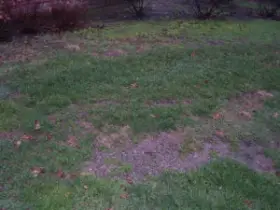
Why does my yard still have weeds?" This is the most common question asked by homeowners who treat their lawns. Unfortunately there is no simple answer. In fact the answer may vary lawn to lawn, but there are several factors that influence the growth of weeds. We'll cover those here.
1. Bare spots. If your lawn has patches exposed soil, it is extremely susceptible to weeds. Weed seeds are spread by wind and animal droppings and can be transferred via contact with clothing/shoes. Like most plants, when a weed seed hits bare soil it will grow. The best way to prevent weeds in bare spots is to fill in the bare spots with grass. Mix grass seed with potting soil in a bucket and place the mix on the bare spots. Keep it damp (watering as much as needed to keep it from drying out, but don't over soak it) until the grass starts to germinate and grows to 3 inches. Then water once daily and mow once the grass is 4-5 inches. This may take 2-3 weeks, so be patient.
2. Thin spots. So maybe your lawn has no bare spots, but maybe the grass is thin. If you can see the soil through the grass, then it's thin. Thin spots often occur in areas of heavy shade (under trees) or in areas of high traffic. If your lawn is thin, try aerating and seeding in the fall. This helps thicken the turf.
3. Excessive edging. If you edge your walkway/driveway frequently or if you edge with a shovel, you may be creating opportunities for weeds. It's all about exposed soil. If you can see dirt after you edge, so can weeds. Try edging less frequently or with a weed trimmer designed for edging. The weed trimmer will only cut the grass along the walkway/driveway and won't expose as much soil. Never dig a trough along the walkway with a shovel.
4. Mother Nature. You can't beat Mother Nature. Weeds have one mission and that is to reproduce and grow. Even thick lawns will develop a few weeds, and these are best treated with a lawn-safe weed herbicide. If your lawn has weeds, let us know and we can recommend a solution.
